Rainlily, Zephyranthes and Habranthus spp.: Low-Maintenance Flowering Bulbs for Florida Gardens1
What is a rainlily?
Rainlily refers to any of about 70 species of Zephyranthes and Habranthus, all of which are flowering bulbs that share common names of rainlily, fairy lily, rainflower and zephyrlily.
These small bulbs earned the name "rainlily" because they often flower within a few days after rainfall. From spring through fall, rainlily can produce flushes of star-shaped, trumpet-like flowers that are white, pink or yellow, depending on the species. Flowers of some new hybrids are in shades of peach, orange and red, and some have multicolored flowers in striped or picotee patterns. Rainlily's easy care, broad adaptability and beautiful, starry flowers make it ideal for gardens in Florida!
Rainlily flowers in spring, summer or fall, depending on species and garden conditions. Each six-petalled, funnel-shaped flower is perched at the top of a stem that ranges in height from 2 inches to more than 12 inches. Zephyranthes spp. have a single, upward-facing or slightly nodding flower on each stem, whereas Habranthus spp. flowers are held at an angle and occur in groups of two or three per stem. Each flower lasts just a day or two, depending on sunlight and temperature, but typically new flowers continually develop for several days, creating flushes of flowering. Rainlily flow- ers best when triggered by rainfall. Irrigation can stimulate flowering, but not to the extent of rainfall.
Rainlily bulbs produce clumps of narrow, grass-like leaves that range in length from a few inches to as long as 14 inches. In the wild, rainlily bulbs adapt to seasonal dry weather by losing leaves until rainfall resumes. In the garden, soil moisture usually is sufficient for most species to retain their leaves throughout much of the year such that they are effectively evergreen. Most rainlily species are hardy in US Department of Agriculture Zones 7–11, an area that includes all of Florida and most of the rest of the southeastern United States (https://planthardiness.ars.usda.gov/PHZMWeb/). However, even in these zones, rainlily leaves may die back after a hard freeze or during extended drought.
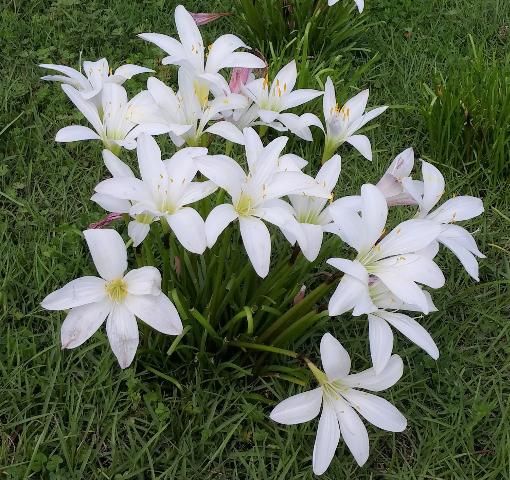
Credit: Gary Knox, UF/IFAS
Common Rainlily Species and Selections
Following are descriptions of common rainlily species and selections listed in order of likely availability. Nonnative Zephyranthes and Habranthus brachyandrus have not been evaluated by the Assessment of Non-native Plants in Florida's Natural Areas (University of Florida 2018) and conditionally may be recommended for use in Florida. Habranthus tubispathus has been assessed as "Not a problem species" and so may be recommended for use throughout Florida (https://assessment.ifas.ufl.edu/assessments/habranthus-tubispathus/).
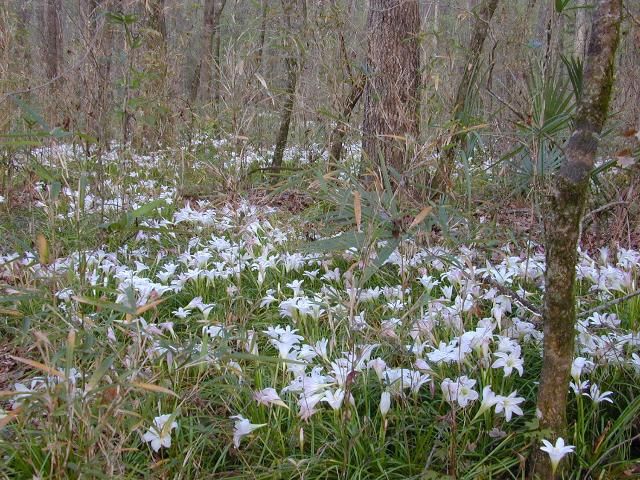
Credit: Gary Knox, UF/IFAS
Zephyranthes atamasca: Native to central Florida, north Florida and the rest of the southeastern United States, this rainlily is commonly known as atamasco lily, rainlily or Easter lily. Flowers appear in March and April and are large, 3 inches wide or larger, white, and funnel-shaped. The flowers are perched on 10-inch stems and will fade to pink. This rainlily is often found in rich, moist soils in swampy forests and coastal prairies and seen in roadside ditches. Clumps of broad, grassy leaves emerge in early winter and die down in late spring or early summer.
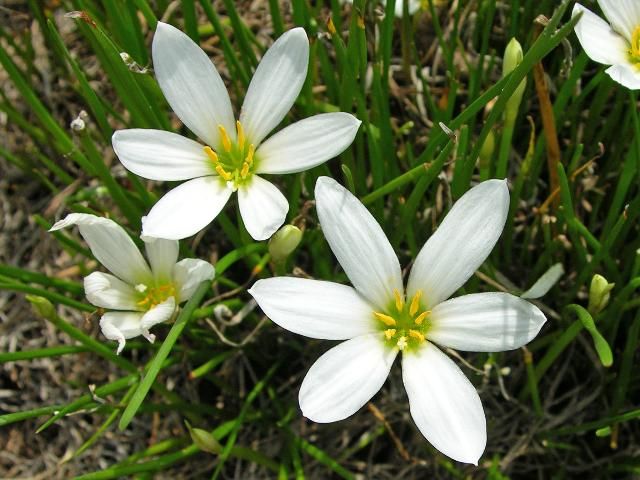
Credit: Gary Knox, UF/IFAS
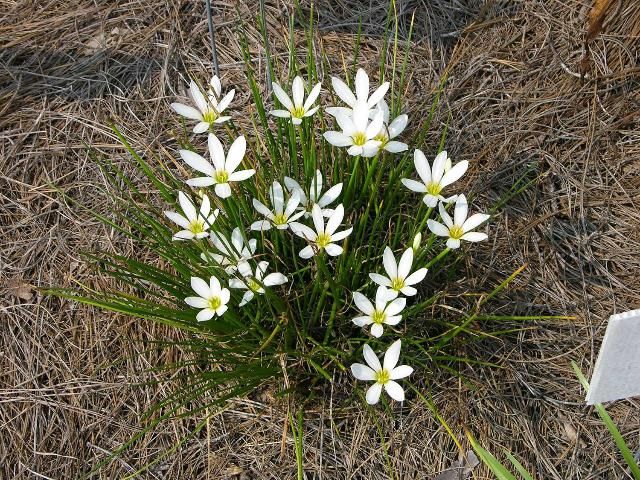
Credit: Gary Knox, UF/IFAS
Zephyranthes candida: Fairy lily or white zephyrlily is native to Argentina and Uruguay, where it is found along rivers and in marshes. This rainlily rapidly forms thick clumps of dark-green, upright, rush-like leaves up to 10 inches tall. In the late summer and fall throughout north Florida and the rest of the southeastern United States, fairy lily produces 1–2 inch, white, crocus-like flowers. This rainlily—evergreen, even in north Florida—is often seen naturalized along roadsides and in ditches.
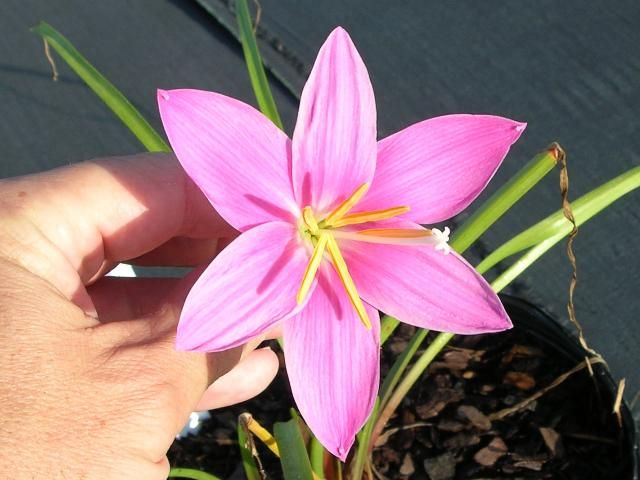
Credit: Gary Knox, UF/IFAS
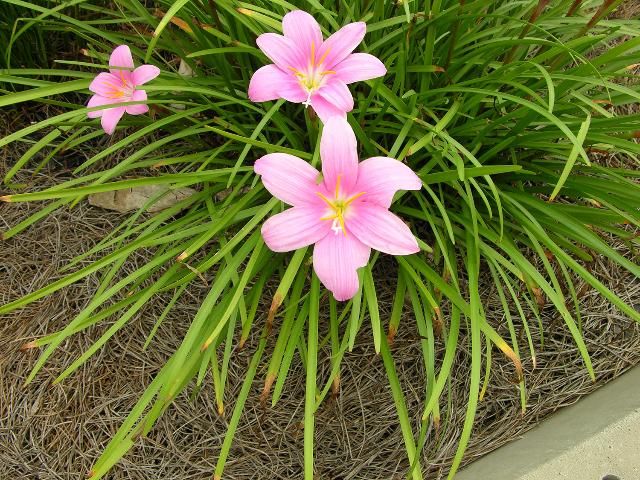
Credit: Gary Knox, UF/IFAS
Zephyranthes grandiflora: Pink rainlily or rosepink zephyrlily is native to Central America and the West Indies islands. Considered by many to be the best of the genus, this rainlily produces bright-pink, funnel-shaped flowers all summer long. Individual flowers are up to 4 inches across and 3 inches long and perched on stems 10–12 inches tall. The cultivated form has sterile flowers and consequently bulbs multiply rapidly in rich, acid soils. Each bulb produces clusters of dark-green, strap-like leaves up to 12 inches long. Clumps can display up to 20 flowers at once. Given the presence of this rainlily in the West Indies islands, the plant is reported to be somewhat salt tolerant. It is sometimes sold as Zephyranthes rosea, though that name belongs to a different species.
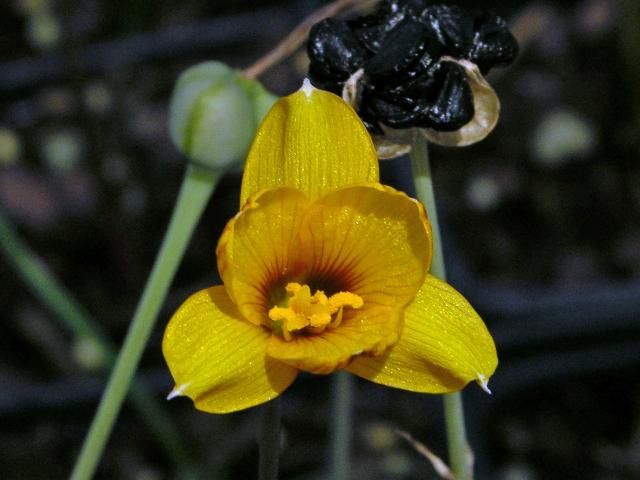
Credit: Gary Knox, UF/IFAS
Habranthus tubispathus: This plant is called "copper lily" because of the abundance of small orange-yellow flowers occurring late summer to fall. The plant performs best in drier soils, and seeds freely to quickly form patches. It has the curious distribution of being native to South America, Central America and areas of Texas and Louisiana.
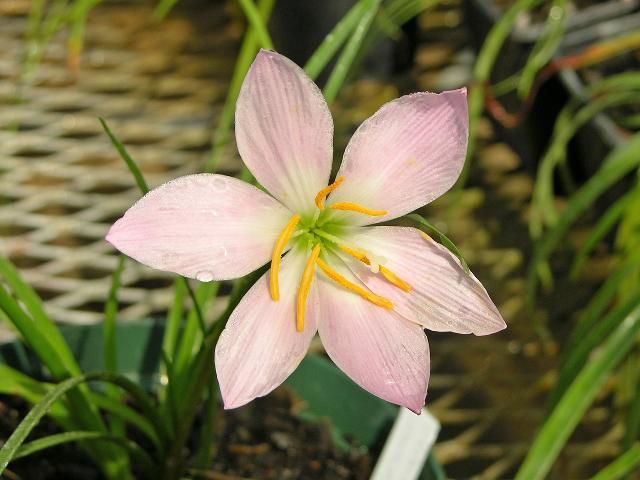
Credit: Gary Knox, UF/IFAS

Credit: Gary Knox, UF/IFAS
Zephyranthes 'Grandjax': Pale pastel pink flowers occur from late summer through fall. Without the burden of producing seeds, this plant flowers heavily and also is very fast growing, resulting in large clumps of bulbs that can be separated and planted. 'Grandjax' rainlily is a hybrid of Z. grandiflora × Z. 'Ajax' (Z. candida × Z. citrina).
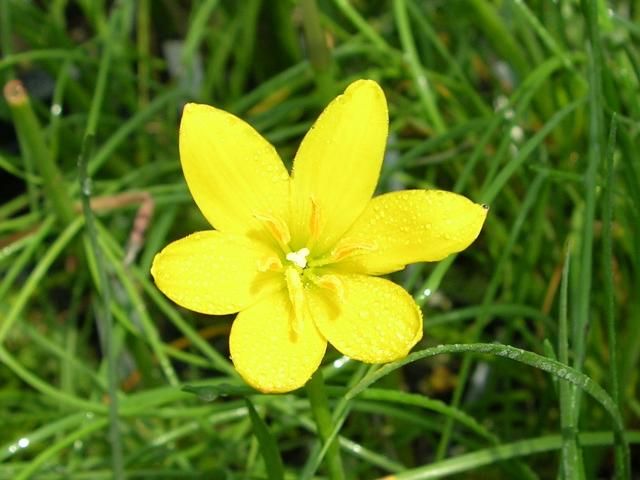
Credit: Gary Knox, UF/IFAS
Zephyranthes citrina: This rainlily is commonly known as yellow rainlily or citron zephyrlily and is native to the Yucatan peninsula of Mexico. Throughout Florida during late summer and fall, these lilies produce small, deep-yellow flowers on stems 8–10 inches long. Leaves of this rainlily are up to 12 inches long. This plant does not offset much, but produces large amounts of viable seed. It is sometimes sold as Zephyranthes sulphurea.

Credit: Gary Knox, UF/IFAS
Habranthus brachyandrus: This rainlily, without a good common name, has large orchid-pink flowers with a burgundy throat that appear in late summer. Native to Argentina and Brazil, this rainlily is more cold tender than most, although plants rapidly produce large clumps of bulbs.
Where should rainlily bulbs be planted?
Rainlily grows best in rich, moist, well-drained soil with a slightly acid to neutral pH. Most rainlily species will flourish under full sun to part shade. Bulbs should be planted in fall or winter about an inch deep and at least 3 inches apart. Rainlily bulbs also are well adapted to grow- ing in containers, provided plants are watered regularly to maintain adequate moisture. Rainlily divisions (small clumps resulting from dividing large clumps) or plants (as purchased in containers from a nursery) can be planted in the garden anytime and often flower and multiply faster than plants established from dormant bulbs.
How much care does rainlily require?
Rainlily is one of the easiest bulbs to grow in Florida. When planted in an appropriate site, rainlily needs little care after planting; it tolerates most soil conditions and will not need fertilizer, irrigation or replanting. Rainlily seems to flower best when clumps are left undisturbed.
Like other bulbs, rainlily adapts to drought and other harsh conditions by going dormant. Leaves will reappear when conditions again are suitable. Unfortunately for gardeners in Florida's coastal areas, most rainlily species are not salt tolerant.
How can rainlily be used in the garden?
Rainlily can be used like any bulb or other small, flowering perennial in the garden. Rainlily is very effective when planted as part of perennial beds, flower gardens, rock gardens, groundcover beds and containers. Rainlily especially mixes well with other bulbs since the evergreen foliage of most rainlilies is an effective foil for other flower- ing bulbs. Because rainlily foliage resembles liriope and mondo grass, rainlily can substitute for these plants when used as a border, as an edging for beds, or to line pathways and sidewalks. Rainlily species such as Z. candida can be used in water gardens.
What pests affect rainlily?
Few pests affect rainlily. Bulbs and other plant parts of Zephyranthes and Habranthus species contain the poisonous alkaloid, lycorine, and other components that can cause vomiting, diarrhea, convulsions and sometimes death in humans and other animals. Although rainlily bulbs are considered to have low toxicity, homeowners should be aware of the poisonous potential of rainlily, particularly if small children and/or pets are present. However, these poisonous components make rainlily resistant to damage from deer, rodents and insects. Snails and slugs are the only pests reported to feed on rainlily leaves.
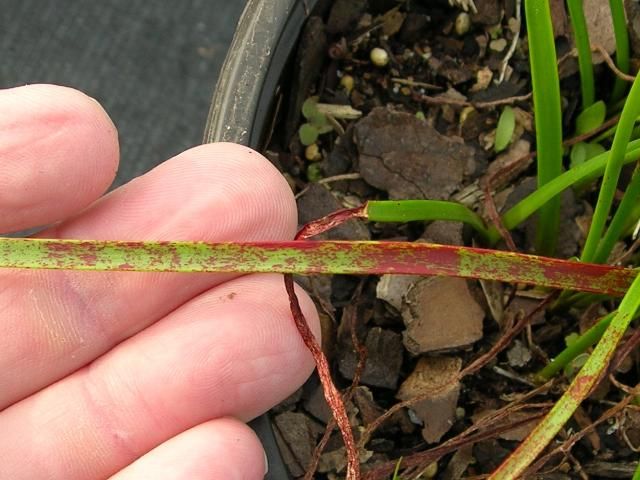
Credit: Gary Knox, UF/IFAS
The disease red blotch (Stagonospora curtisii) occurs occasionally in rainlily during cool, damp weather. As the name of this disease implies, it appears as a streak or blotch of dark red on leaves. This disease does not significantly harm rainlily, but primarily affects the plant's appearance, and leaves forming at times other than during cool, damp weather will not show red-blotch symptoms. Rainlily is not as susceptible to this disease as is amaryllis (Hippeastrum spp.).
Where is rainlily native?
Species of rainlily are native to warm-temperate and tropical parts of the Americas, including Florida and the rest of the southeastern United States. Rainlilies are often found in swamps, marshes, prairies and moist soils. In recent years, plant breeders have been hybridizing rainlily to develop new flower colors, such as peach, apricot, orange and red.
Rainlily species are members of the amaryllis family, which includes other bulbs that are popular among gardeners, including amaryllis (Hippeastrum spp.), daffodils (Narcissus spp.), snowflakes (Leucojum spp.) and hurricane lilies (Lycoris spp.). The scientific name for rainlily, Zephyranthes, is derived from Zephyrus, the Greek god of the west wind that typically brought the rainfall with which these plants are associated.
How can rainlily be propagated?
Most rainlily species are easily propagated by bulbs, division or seed. Depending on the species, bulbs range in size from ½ inch to more than 2 inches in diameter.
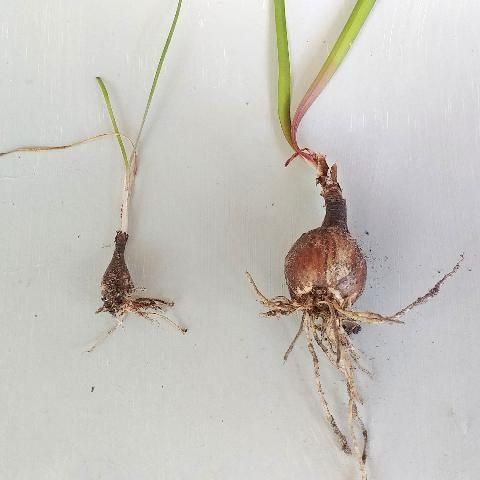
Credit: Gary Knox, UF/IFAS
The easiest way to propagate rainlily is to divide clumps. Large clumps of bulbs need to be divided every few years. Divisions of rainlily clumps establish and flower more quickly if each division consists of a grouping of three or more bulbs. The best time to divide clumps of bulbs is when they are dormant (winter for most types).
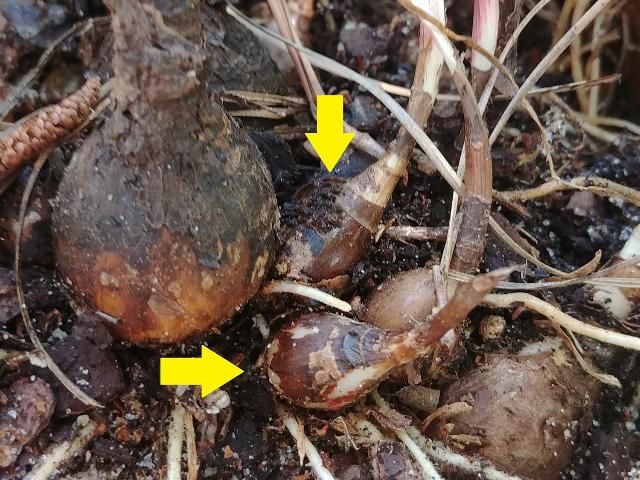
Credit: Gary Knox, UF/IFAS
Most rainlily species rapidly produce offsets or bulblets, small bulbs at the base of the parent bulb. Each bulblet can be detached and planted separately. However, individually planted bulbs or bulblets often take longer to develop into flowering clumps. The number of growing seasons required for a bulblet to reach flowering size will depend on the kind of bulb and size of the bulblet.
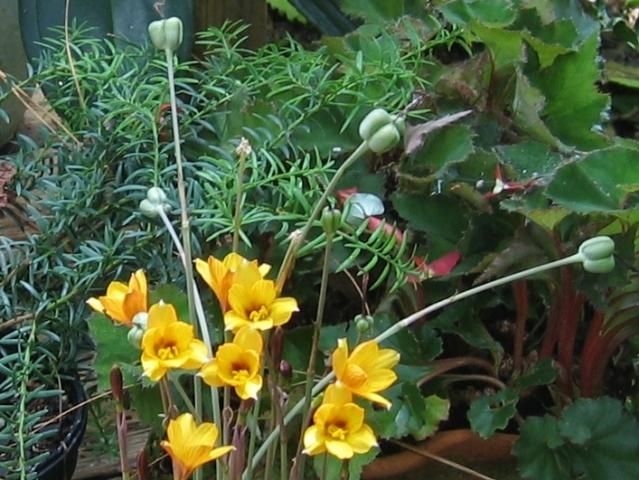
Credit: Gary Knox, UF/IFAS
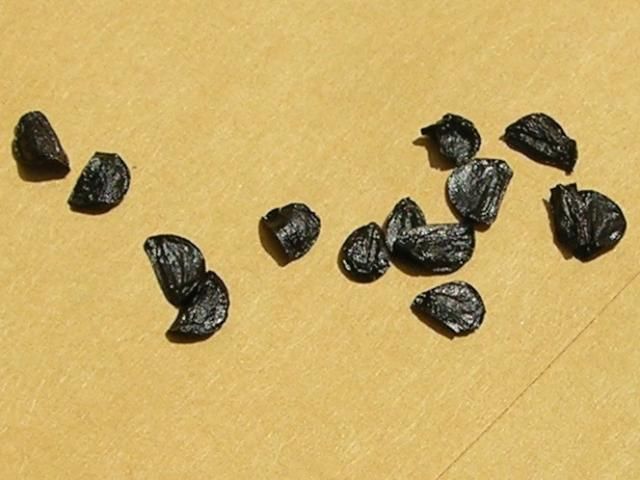
Credit: Gary Knox, UF/IFAS
For many rainlily species, as the flowers fade, they develop small capsules that contain viable seeds. These shiny black seeds can be collected from the capsules when they turn yellow and begin to split. Because seed viability rapidly decreases after harvest, sow fresh seeds on a moist potting soil and lightly cover. Germination will occur in two to six weeks. Under ideal conditions, seedlings will flower in eight to twelve months.
Where are rainlily bulbs and plants sold?
Rainlily bulbs or plants can be found at garden centers and Internet or mail-order nurseries.
Gardeners can plant rainlilies and forget them and still be rewarded with flushes of cheerful flowers that seem to appear overnight.
References
Davis, Alani. 2009. Personal communication. Tallahassee, Florida.
Flora of North America. 2002. Zephyranthes. http://www.efloras.org/florataxon.aspx?flora_id=1&taxon_id=135293
Ogden, Scott. 2007. Garden Bulbs for the South, 2nd edition. Portland, Oregon: Timber Press, Inc.
University of Florida Institute of Food and Agricultural Sciences. 2018. Assessment of Non-native Plants in Florida's Natural Areas. Accessed 14 October 2020. https://assessment.ifas.ufl.edu
Pacific Bulb Society. 2019. Zephyranthes. https://www.pacificbulbsociety.org/pbswiki/index.php/Zephyranthes. Pacific Bulb Society.


